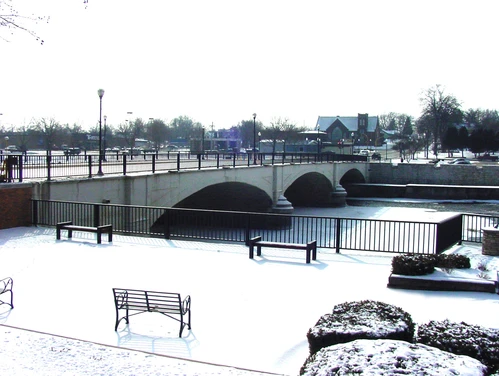- Years constructed: 1909-1910
- Alternate name: Cedar River Bridge
- Bridge type: Concrete Filled Spandrel Arch
- National Register of Historic Places status: Listed
- Length: 248 feet
- Width: 50 feet
- Spans: 3
- FHWA: 001820
- Jurisdiction: City of Charles City
- Location: Main Street over the Cedar River in Charles City, Section 12, T95N-R16W (St. Charles Township)
Details
Early settlers in the Charles City area crossed the Cedar River by ferry or at a ford during the summer, and over the thick ice in the winter. The townspeople first resolved to build a 190-foot timber bridge at Mill Street (now Main Street) in 1857, but the structure was swept away by a flood in 1858 before it was completed. A second bridge, built in 1864, was partially destroyed by a flood two years later. A temporary timber bridge, installed in 1867, was later replaced in 1870 by a 2-span, 250-foot iron truss bridge, designed and built by W.H. and L.E. Truesdell of Belvidere, Illinois, for $14,422.50. It survived for nearly 40 years, despite an engineer's study in 1892 that concluded: "The bridge is not safe. It should be condemned and replaced by a suitable structure."
It was not until April 1908 that county supervisors approved construction of a new bridge at this site. They first awarded the contract to the Des Moines-based Marsh Bridge Company for the sum of $33,500; but financial problems with the company at the time delayed the project and the contract was cancelled. In March 1909 the board finally selected the bid of the Advance Construction Company of Waukesha, Wisconsin. Plans for the bridge were prepared by Advance's "Designing Engineer" G.W. Miller; W.A. Hey served as construction supervisor. (The Miller-Hey Construction Company, based in Des Moines, was founded after this bridge was constructed.) The Cedar River Bridge was completed by 1910 for approximately $40,000. The concrete barrel arch style was popular during this period, particularly for major urban crossings.
Iowa's major urban bridges have followed a definite technological progression, reflecting evolution and development of more durable bridge types. The concrete spandrel arch were first built after 1905 in cities such as Waterloo, Iowa City, Charles City and Mason City, over the Cedar, Iowa and Shell Rock rivers. Although far more durable than the lightweight metal bridges that preceded it, the concrete arch form was itself superseded in later years by other, more efficient bridge configurations. Between 1905 and 1920, however, it was the predominant structural type for large-scale urban crossings, for both structural and aesthetic reasons. The Main Street Bridge in Charles City is noteworthy among the remaining urban arch bridges in Iowa for its relatively early construction date and for its well-preserved condition. A major crossing in the city and the county, it is a technologically and historically important transportation-related resource.
Adapted from Hybben, Roise and Fraser 1992
Areas Served
- Floyd
